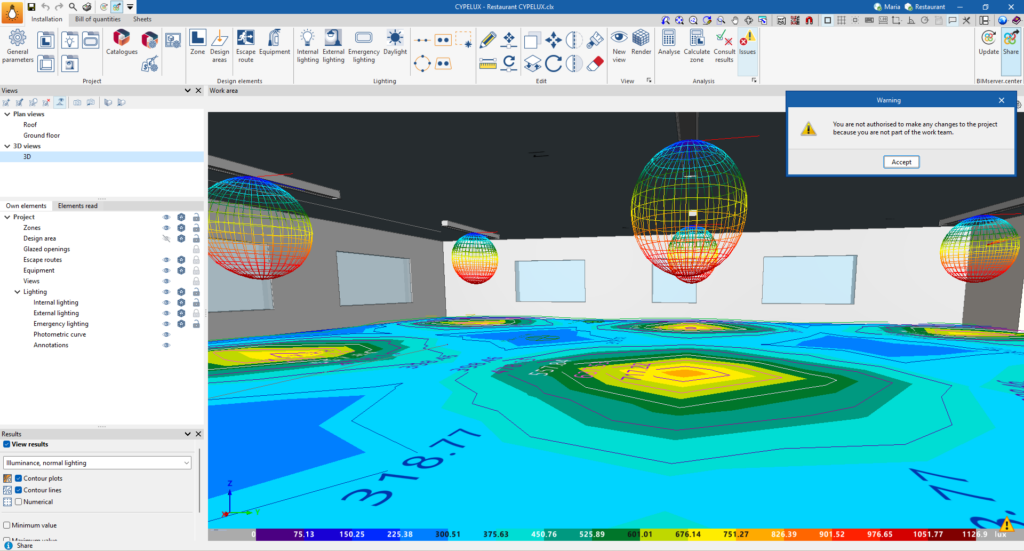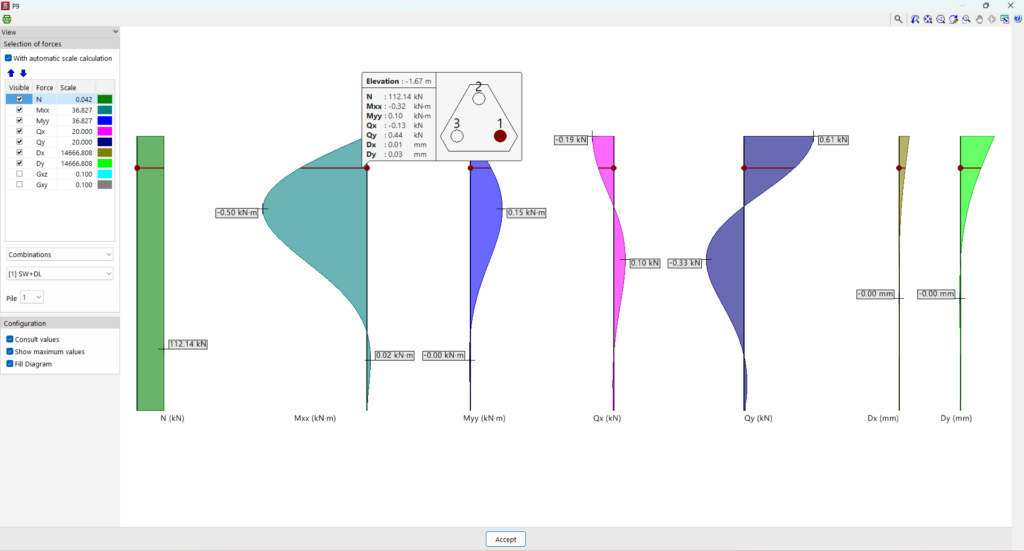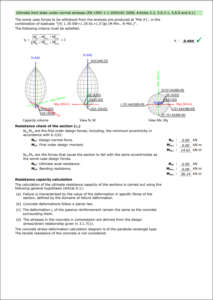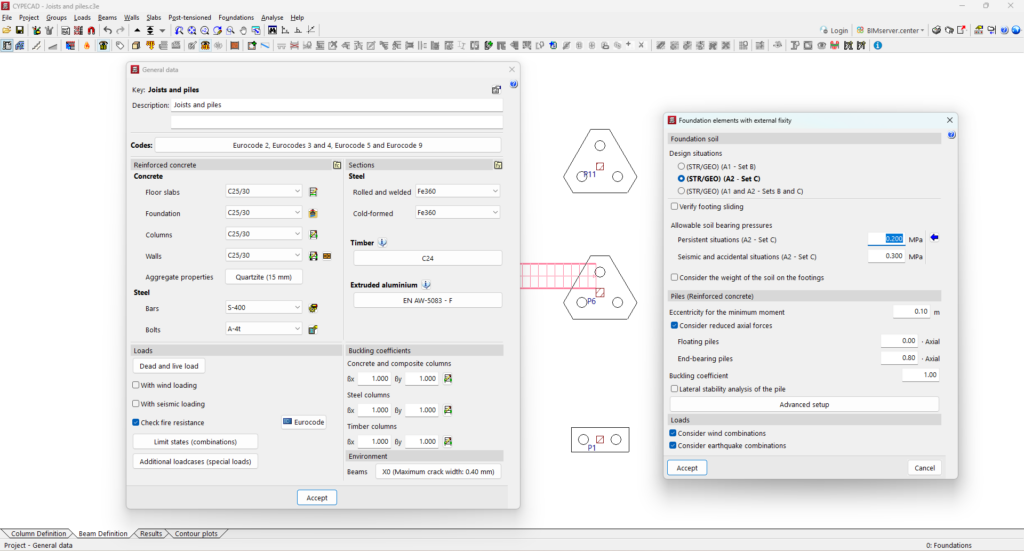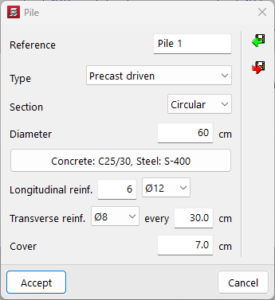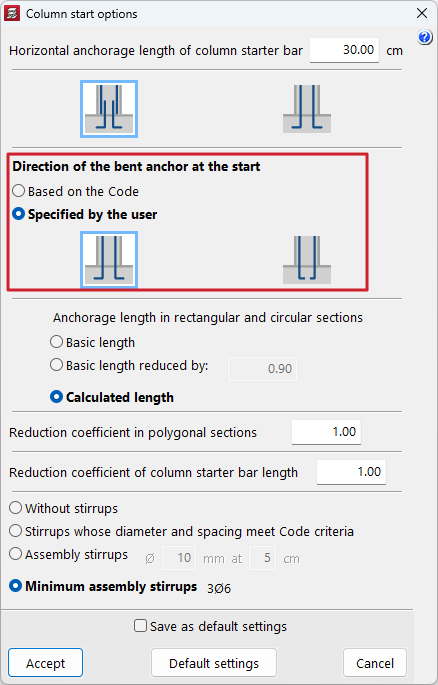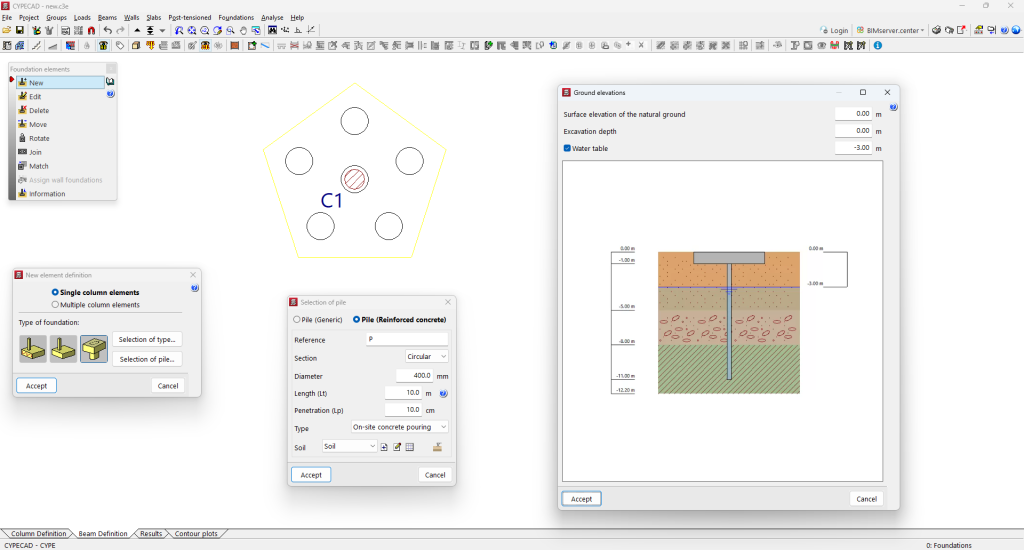As of version 2025.d, when clicking the "Share" option of the apps (before starting the generation of the contribution files), a check is made to ensure that the user is part of the BIMserver.center project team. If the user does not have the appropriate permissions, a warning message is displayed. This prevents the generation of unnecessary files when the user does not have editing rights.
Update history
CYPECAD
Checking permissions when sharing a contribution in the BIMserver.center project
- AcouBAT by CYPE, Arquimedes, CYPE 3D, CYPE Architecture, CYPE Connect, CYPE Connect Classic, CYPE Construction Systems, CYPE Cost Estimator, CYPE Gas Supply, CYPE Sewerage, CYPECAD, CYPEFIRE, CYPEFIRE FDS, CYPEFIRE Hydraulic Systems, CYPEFIRE Pressure Systems, CYPEHVAC Radiant Floor, CYPEHVAC Schematics, CYPELEC, CYPELEC Distribution, CYPELEC Electrical Mechanisms, CYPELEC MULTILINE, CYPELEC Networks, CYPELEC PV Systems, CYPELUX, CYPEPLUMBING, CYPESOUND, CYPETEL Wireless, CYPETHERM C.E., CYPETHERM EPlus, CYPETHERM LOADS, CYPEURBAN, IFC Builder, Open BIM Analytical Model, Open BIM Cable Routing, Open BIM Layout, Open BIM Model Checker, Open BIM Quantities, Open BIM Site, Open BIM Switchboard, Plugin Open BIM - Revit, Portal frame generator, StruBIM Box Culverts, StruBIM Cantilever Walls, StruBIM Deep Beams, StruBIM Embedded Walls, StruBIM Shear Walls, StruBIM Steel
- Published on
- 2025.d
BIMserver.center new features window
As of version 2025.d, the "Project selection" window in the apps connected to BIMserver.center incorporates a new notification system to inform users about the latest new features on the platform.
This space displays relevant messages about new features, enhancements and recommendations related to BIMserver.center. In addition, direct links to documents, tutorials and additional resources will be included to facilitate the adoption of these new features.
- AcouBAT by CYPE, Arquimedes, CYPE 3D, CYPE Architecture, CYPE Connect, CYPE Connect Classic, CYPE Construction Systems, CYPE Cost Estimator, CYPE Gas Supply, CYPE Sewerage, CYPECAD, CYPEFIRE, CYPEFIRE FDS, CYPEFIRE Hydraulic Systems, CYPEFIRE Pressure Systems, CYPEHVAC Radiant Floor, CYPEHVAC Schematics, CYPELEC, CYPELEC Distribution, CYPELEC Electrical Mechanisms, CYPELEC MULTILINE, CYPELEC Networks, CYPELEC PV Systems, CYPELUX, CYPEPLUMBING, CYPESOUND, CYPETEL Wireless, CYPETHERM C.E., CYPETHERM EPlus, CYPETHERM LOADS, CYPEURBAN, IFC Builder, Open BIM Analytical Model, Open BIM Cable Routing, Open BIM Layout, Open BIM Model Checker, Open BIM Quantities, Open BIM Site, Open BIM Switchboard, Plugin Open BIM - Revit, Portal frame generator, StruBIM Box Culverts, StruBIM Cantilever Walls, StruBIM Deep Beams, StruBIM Embedded Walls, StruBIM Shear Walls, StruBIM Steel
- Published on
- 2025.d
Piles III: Lateral stability analysis (new module)
In version 2025.d, the CYPECAD, CYPE 3D and Foundation Elements programs incorporate the lateral stability analysis module to facilitate the design of deep foundations subjected to significant lateral forces.
This module complements the structural check of reinforced concrete piles (if your licence includes the "Piles II: Structural check" module), by allowing the checking of pile sections and reinforcements under various loading scenarios. For this purpose, the soil characteristics are integrated by means of p-y curves, and the non-linear behaviour of the soil is considered in the analysis.
The analysis is carried out using the OpenSees© analysis engine and is based on a finite element model where the behaviour of the soil is assimilated to a series of non-linear springs. The stiffnesses of these springs are determined according to the geotechnical parameters previously defined in the specifications of the soil layer.
The forces and displacements obtained at each point can be viewed on screen and exported to a CSV file. Furthermore, if your license includes the "Piles II: Structural check" module, the calculated forces are used to check the reinforcement of the pile section in accordance with the applicable codes.
To use this module, the following permissions are required in the license, depending on the program to be used:
- In CYPECAD
"CYPECAD", "Pile caps", "Piles III: Lateral stability analysis" and "OpenSees©. Professional version". - In CYPE 3D
"CYPE 3D", "Pile caps", "Piles III: Lateral stability analysis" and "OpenSees©. Professional version". - In Foundation elements
"Foundation elements", "Piles III: Lateral stability analysis" and "OpenSees©. Professional version".
- Published on
- 2025.d
Piles II: Structural check (new module)
In version 2025.d, the CYPECAD, CYPE 3D and Foundation elements programs incorporate structural checking of reinforced concrete piles for deep foundations.
The new module "Piles II: Structural check" complements the design of this type of foundation, verifying the safety of piles as a structural element of reinforced concrete according to the criteria of the selected codes.
The program can be used to easily define the section of the piles and their reinforcement and to check their resistance to the forces transmitted by the pile cap to the pile head. If the lateral stability analysis is carried out, the stresses obtained from this analysis are also taken into account. The lateral stability analysis is part of the other pile module implemented in this version "Piles III: Lateral stability analysis".
In the "General data > Foundation elements with external fixity" panel, some options have been implemented that allow considering minimum values of the bending moment and axial force to be considered, as well as setting the buckling length of the pile for the calculation. These values can also be modified for each pile cap individually.
The verification has been implemented for the entire collection of codes available in the CYPECAD, CYPE 3D and Foundation elements programs.
To use this module, the following permissions are required in the license, depending on the program to be used:
- In CYPECAD
“CYPECAD”, “Pile caps” and “Piles II: Structural check”. - In CYPE 3D
“CYPE 3D”, “Pile caps” and “Piles II: Structural check”. - In Foundation elements
“Foundation elements” and “Piles II: Structural check”.
- Published on
- 2025.d
"Piles II: Structural check" and “Piles III: Lateral stability analysis” (new modules for CYPECAD, CYPE 3D and Foundation elements)
Version 2025.d includes two new modules for checking and analysing piles (Piles II and Piles III) in CYPECAD, CYPE 3D and Foundation elements.
In the previous version 2025.c, the Piles I module was already implemented in the same programs. Therefore, as of version 2025.d, users of CYPECAD, CYPE 3D and Foundation elements have three pile modules that complement the design of deep foundations using pile caps. The three pile modules are the following:
- Piles I: Calculation of sinking load (v.2025.c)
This module, already implemented in the previous version (2025.c), is used to verify the bearing capacity of reinforced concrete piles under different loading conditions, taking into account the characteristics of the soil and of the pile itself. More information on this module can be found in the new features of version 2025.c.
In version 2025.d, the Piles I module includes a new feature in the pile sinking resistance analysis by allowing the selection of two analysis modes. More information on this can be found in the new feature of this version "Analysing the sinking resistance of piles using allowable bearing pressures".
- Piles II: Structural check (v.2025.d)
Implemented in this version (2025.d), Piles II offers the possibility to easily define the pile section and its reinforcement, and thus to check its resistance against the requesting forces transmitted by the pile cap to the pile head. More information on this module can be found in "Piles II: Structural check (new module)" in the new features of this version.
- Piles III: Lateral stability analysis (v.2025.d)
Also implemented in version 2025.d, Piles III incorporates the lateral stability analysis to facilitate the design of deep foundations subjected to significant lateral forces. This module can be used to carry out the checks of the "Piles II: Structural check" module (if it is included in your license) also considering the lateral forces transmitted by the pile cap to the head of the piles. The analysis is carried out using the OpenSees© analysis engine and is based on a finite element model where the behaviour of the ground is assimilated to a series of non-linear springs. More information on this module can be found in "Piles III: Lateral stability analysis (new module)" in the new features of this version.
To use this module, the following permissions are required in the license, depending on the program to be used:
- In CYPECAD
“CYPECAD”, “Pile caps” and the pile modules you wish to use. - In CYPE 3D
“CYPE 3D”, “Pile caps” and the pile modules you wish to use. - In Foundation elements
“Foundation elements” and the pile modules you wish to use.
In addition, in any of the three programs listed above, the user license must also have the "OpenSees©. Professional version" if the "Piles III: Lateral stability analysis" module is one of the modules being used.
- Published on
- 2025.d
Other improvements and corrections
CYPECAD version 2025.c includes the following program improvements and corrections for some specific cases:
- The "Direction of the bent anchor at the start" option has been added under "Forces in columns, shear walls and walls > Reinforcement arrangement". The default direction can be selected according to the standard, or to specify "Towards the outside" or "Towards the inside".
- The "Export forces to design connections" option (BIMserver.center menu > Share) has been improved. The forces of steel inclined beams, bracing diagonals and V-bracings are now exported.
- An error that could occur when designing the foundations of a building if a beam is split during the analysis process due to a change in the dimensions of a steel column has been solved.
- An error that could occur when entering concrete group walls if the entered wall was located next to a concrete wall has been fixed.
- The detection of the final floor of staircases and ramps has been improved. In certain cases, when the landing level of a staircase or ramp matched the level of the floor slabs belonging to two floors, the final floor could be detected incorrectly. This was due to an incorrect optimisation in the search for this floor.
- An error that could occur when analysing a job with an earthquake has been solved. This error occurred after showing an issue that did not allow the analysis of the job to be carried out.
- The final design report has been improved. The verification of the stability coefficient per storey is carried out at the end of the job analysis. Previously, this was done each time the job was opened after the analysis. This could cause a considerable time delay when opening large jobs.
- An error that could occur when selecting "Forces in columns, shear walls and walls" has been fixed. This error occurred if a column entered as "Start" was selected.
- The "Cover" option has been included in "Panel manager > Copy panels". This way, users can copy the assigned covers defined for one specific panel to other panels.
- An error that used to occur when designing portal frames has been fixed. Depending on the concrete code, this error could occur when defining a portal frame with a span with a smaller depth than its two adjacent spans.
- The number of decimal places in the "Calculated" value in the "Ground bearing pressures" check of the foundation elements has been reduced. This avoids non-compliant checks such as the following example:
- Mean stress in persistent situations.
- Maximum 0.2MPa
Calculated 0.2000516 NOT VERIFIED
- Maximum 0.2MPa
- Mean stress in persistent situations.
- An error that occurred systematically when designing foundation pits with the "NTC: 2023 (Mexico)" standard has been fixed.
- An error that could occur when designing columns and having "Without stirrups" selected in the "Column start options" option has been solved.
- An error that could occur when exporting reinforcement if variable depth beams were defined in the job has been fixed.
- The configuration panel of the "Contour plots" drawing has been improved to display the names of the loadcases and combinations better.
- An error that could occur when running the "Bills of quantities" option (File > Export menu) has been fixed. This error could occur in some floors due to discrepancies between the floor slab measurement surfaces. Now, in these cases, the user is warned of these discrepancies instead of receiving an error.
- In integrated 3D structures, the "Connection information" option has been improved in the case of connections on beams and spans.
- The foundation elements drawing has been modified. When selecting "Column start options > With no overlap at the foundation starts", the length of the start bars shown in this drawing did not coincide with the length shown in the detailed column drawing. A note is now displayed to consult this detailing in the "Column detailing" drawing.
- Entering connections for integrated 3D Structures has been improved. When entering new connections, the X and Y coordinates of the connections are checked to see if they are close to other previously entered connections and, if so, the user is prompted to decide which values are correct.
- The "General data" option ("Project" menu) has been improved. As of version 2025.c, if the foundation concrete is modified, the analysis results are not lost if no foundation beams or slabs have been defined in the job.
- The "3D view with details" option has been improved ("Results" tab > "Groups" menu > "3D view with details" option) and the export of reinforcement bars of slabs with two planes has been improved. Previously, they were only generated in one of these planes.
- An error that occurred when generating the report of quantities in the job has been fixed. This error could occur when defining bolts in the punching shear reinforcement and, after having entered them, the section of the columns was modified so that they had less surface area.
- The drawing of beams has been improved. If a beam end has "Partial fixity" defined, the same symbol as used for unfilled hinged ends is shown.
- An error that could occur when importing a job from an IFC if there are columns defined in the IFC but none of them are defined correctly has been fixed.
- The import of jobs from an IFC has been improved. Since version 2024.d, steel columns defined in the IFC could not be imported due to a program error caused by a bug fix.
- An error that could occur in the "Recover reinforcement copy of all groups" option in the "Flat/Waffle slabs" menu has been fixed. This error could occur very rarely in floors where waffle slabs and solid slab floors had been defined with the longitudinal reinforcement of one of the slab types rotated 90º with respect to that of the other type.
- An error that occurred when designing frames has been fixed. This error was detected only on computers with 24 processors and could occur if several of them could not be designed simultaneously when designing several frames.
- The detailing of the column starts has been improved. The positioning of the stirrups has been modified to distribute them uniformly.
- The detailing of columns that start on top of other columns has been improved. The start reinforcement is now generated with straight extensions instead of bends.
- An error that could occur when designing wall footings has been fixed. This error occurred in some cases of footings with a considerable length when the difference of the y-coordinate of their ends was between the values "0" and "0.5 mm".
- An error that could occur with the "Share" option in the "BIMserver.center" menu has been fixed. This error occurred very rarely if "Export forces to design connections" was checked. This could happen if two processors were trying to start reading the forces of columns with a steel or timber section at the same time.
- An error related to the definition of staircases has been fixed. In some cases, the "No support element has been entered for the end of staircase..." error was displayed incorrectly.
- An error that occurred when checking concrete nodes has been fixed. The error occurred when generic section concrete columns were entered.
- An error that occurred during punching checks of bolts has been fixed. This error could occur if, after inserting bolts close to a column, the section of the column was reduced.
- An error regarding the analysis of a job with hollow core plates has been fixed. This error was due to an implementation issue in the "Layers > Assign covers" option developed in version 2025.b.
- An error that occurred in the 3D view of staircase reinforcement bars or when using "Share - Reinforcement" in BIMserver.center has been fixed. The error could occur in the case of horizontal slabs without transverse reinforcement.
- An error in the design of beam frames has been fixed. This could occur very rarely when analysing the deflection of portal frames with beams on walls.
- The import of beam reinforcement tables for ACI 318M-19 has been improved. The selection of tables created for ACI 318M-14 and ACI 318M-11 is now permitted.
- An error that occurred in ‘’Drawings‘’ when clicking on the ‘’Add‘’ option has been solved. This error could occur if CYPE 3D integrated 3D structures with views associated with levels had been imported into the job and the integrated 3D structure had not been edited.
- An error that occurred in some circumstances when selecting a steel beam in "Beams/Walls - Beam errors" has been fixed.
- The entry of connections for Integrated 3D structures has been improved. When entering new connections or moving existing ones, the lines of the integrated 3D structure drawing can be snapped as if it were a DXF/DWG template.
- An error that could occur when consulting the checks of a beam portal frame has been fixed. This error could occur, in some cases, when consulting the "Resistance to torsion" check of the "Fire resistance" type.
- The editing of "Beam alignments" has been improved. "Undo" and "Redo" can now be used after using the "Divide an alignment", "Reorganise", "Assign number", "Assign reference" and "Multiple assignment" options.
- The "Check the geometry of the current group", "Check the geometry of the current group and higher groups" and "Check the geometry of all groups" options have been improved. After carrying out any of these actions, the order of beam alignments could be lost if it had been previously changed.
- An error in the "Contour plots" tab has been fixed. In jobs with very large floors (the case where the problem was detected was over 4000 m2), when consulting the results, an error that prevented the program from continuing to run could occur.
- An error has been fixed in Integrated 3D Structures. This error was systematic and occurred when entering aluminium sections, either by importing a CYPE 3D job with this type of section or by defining them in a structure entered with "New structure". This error arose due to changes made in version 2025.a.
- An error has been fixed when selecting the "Slabs/Waffle slabs-Punching shear" option for a slab with two openings separated by a beam.
- Relative deflection analysis has been improved for joist floor slabs, hollow core slabs and composite slabs. In these cases, the span (L) is considered to be twice the span of the overhang.
- An error that could occur when drawing column references has been fixed. This error could occur in some cases, after changing a column section from generic to rectangular.
- An error that occurred when obtaining the frame drawings if any of them consisted of a single circular span has been fixed.
- An error that occurred in the analysis process after displaying a warning of incorrect geometry in the vicinity of a point has been fixed. Now, after the warning, the analysis process is terminated without stopping the program.
- The drawing of beam axes has been improved. In the case of the meeting of two almost parallel tie beams or centring beams in a footing, the drawing of the axis of one of these beams could be extended to the meeting of both axes.
- The assignment of base reinforcement to flat slabs has been improved. When there were several panels with different depths, sometimes the selected base reinforcement could not be assigned to all of them, which meant that the desired reinforcement had to be re-entered after selecting each panel.
- Published on
- 2025.c
Column definition. Modify angle - Snap
The "Snap" option has been added to the "Modify angle" dialogue box ("Column definition" tab > "Entry" menu > "Modify angle" option). By pressing this button, a segment of a DXF/DWG template can be selected to copy its angle. Depending on where the cursor is placed, either nearer to one end or the other, the origin of the segment defining the angle is selected.
- Published on
- 2025.c
Contour plots. Value at a point
The "Value at a point" option has been added to the "Contour plots" tab. With this option, the value of the contour plots displayed anywhere in the floor can be consulted.
- Published on
- 2025.c
Copying the reinforcement of another wall
The "Copy the reinforcement of another wall" option (‘Results > Beams/Walls’) has been implemented to copy the reinforcement from one wall to another. To copy the reinforcement, the walls must have the same number of floors.
- Published on
- 2025.c
Participation coefficients
The "Participation coefficients" option has been added to the "Results > Envelopes" menu. This option allows users to consult the "Participation coefficients" table included in the "Justification of seismic action" report when a dynamic modal spectral analysis is carried out.
- Published on
- 2025.c
Beam editor: Edit section
In the beam editor, the "Edit section" option has been added, which allows the section dimensions of the different spans of the portal frame to be modified without having to exit the editing panel.
- Published on
- 2025.c
Piles: Calculation of sinking load (new CYPECAD, CYPE 3D and Foundation elements module)
In version 2025.c, the calculation of the sinking load in deep foundations using reinforced concrete piles has been implemented for the "CYPECAD", "CYPE 3D" and "Foundation elements" programs. This implementation has been included in the new module "Piles: Calculation of sinking load".
This module complements the design of deep foundations using pile caps, allowing users to verify the bearing capacity of piles under different load conditions, considering the characteristics of the soil and the pile itself.
To use this module, the user license must have the appropriate permissions depending on the program where it is to be used.
More information on this module common to the CYPECAD, CYPE 3D and Foundation elements programs is available in the new 2025.c version "Piles: Calculation of sinking load (new module)".
- Published on
- 2025.c
